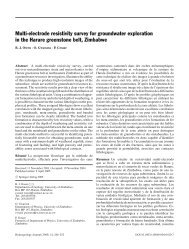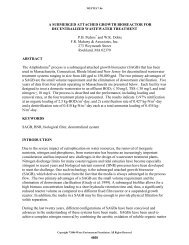Species diversity in the Florida Everglades, USA - Environmental ...
Species diversity in the Florida Everglades, USA - Environmental ...
Species diversity in the Florida Everglades, USA - Environmental ...
You also want an ePaper? Increase the reach of your titles
YUMPU automatically turns print PDFs into web optimized ePapers that Google loves.
Aquat. Sci. Vol. 68, 2006 Overview Article 261<br />
<strong>Florida</strong> applesnail (Pomacea paludosa) deserves special<br />
mention as an important freshwater mollusk <strong>in</strong> <strong>the</strong> <strong>Everglades</strong><br />
due to its predation by a variety of wildlife <strong>in</strong>clud<strong>in</strong>g<br />
young alligators and numerous birds (Kushlan,<br />
1975). The most notable of <strong>the</strong>se birds is <strong>the</strong> snail kite,<br />
which feeds exclusively on <strong>the</strong> applesnail (Lodge, 1994).<br />
It is generally held that <strong>the</strong> chydorid, cladocerans, odonates,<br />
and dipterans are diverse (Gunderson and Loftus,<br />
1993).<br />
Freshwater <strong>in</strong>vertebrates are critical <strong>in</strong> transfer of energy<br />
through <strong>the</strong> <strong>Everglades</strong> system. The <strong>in</strong>vertebrate<br />
community operates at several trophic levels <strong>in</strong> <strong>the</strong> wetlands,<br />
some as primary herbivores of plant material and<br />
consumers of detritus and o<strong>the</strong>rs as carnivores. Some<br />
species, such as <strong>the</strong> crayfi sh and apple snail, are major<br />
prey for fi shes and o<strong>the</strong>r predatory species, <strong>in</strong>clud<strong>in</strong>g<br />
some endangered animals. Factors that <strong>in</strong>fl uence <strong>in</strong>vertebrate<br />
numbers, biomass, and even community composition<br />
<strong>the</strong>refore may have signifi cant effect on energy<br />
transfer through <strong>the</strong> <strong>Everglades</strong>. Obviously, <strong>the</strong> ecology<br />
and life histories of aquatic <strong>in</strong>vertebrates are affected by<br />
<strong>the</strong> hydrology of <strong>the</strong> <strong>Everglades</strong> marsh, which has <strong>in</strong>creas<strong>in</strong>gly<br />
been altered and managed by human practices.<br />
The distributions and overall abundance of <strong>in</strong>vertebrates<br />
appear to be adversely affected by changes <strong>in</strong> fl ood releases,<br />
diversion of water, and impoundments (Science<br />
Subgroup, 1996). Compound <strong>the</strong>se changes by natural<br />
disturbances such as hurricanes and droughts, and <strong>the</strong> net<br />
result is dramatically reduced stand<strong>in</strong>g stocks of <strong>in</strong>vertebrates,<br />
sometimes for years follow<strong>in</strong>g <strong>the</strong> events (Science<br />
Subgroup, 1996).<br />
Fishes. The <strong>Everglades</strong> National Park is home to 432 species<br />
of fi sh from 91 families; approximately 260 species<br />
are observed frequently. The most diverse families are<br />
Cypr<strong>in</strong>idae (m<strong>in</strong>nows and sh<strong>in</strong>ers – 32 species), Centrarchidae<br />
(bass/sunfi sh/crappie – 24), Sciaenidae (drum/<br />
k<strong>in</strong>gfi sh – 18), Percidae (darter/perch – 17), Clupeidae<br />
(shad – 16), Cypr<strong>in</strong>idontidae (topm<strong>in</strong>nows/killifi sh – 16)<br />
and Gobiidae (gobys – 16) (Table 5). A large fraction of<br />
<strong>the</strong> regional fi sh <strong>diversity</strong> <strong>in</strong>habits <strong>the</strong> mar<strong>in</strong>e and estuar<strong>in</strong>e<br />
waters; only 30 species are native to fresh water. Of<br />
those, <strong>the</strong>re are several important game species that attract<br />
thousands of anglers to <strong>the</strong> park each year, <strong>in</strong>clud<strong>in</strong>g<br />
tarpon (Megalops atlantica), and largemouth bass (Micropterus<br />
salmoides). The latter is particularly <strong>in</strong> peril due to<br />
bioaccumulation of mercury and crowd<strong>in</strong>g out by exotic<br />
species. Several smaller fi sh species are extremely important<br />
as food source for wad<strong>in</strong>g birds and larger fi sh. Mosquitofi<br />
sh (Gambusia holbrooki) are <strong>the</strong> most common<br />
freshwater fi sh <strong>in</strong> <strong>the</strong> <strong>Everglades</strong> and are found throughout<br />
<strong>the</strong> park. Several mar<strong>in</strong>e species are also important for<br />
recreational fi sh<strong>in</strong>g, <strong>in</strong>clud<strong>in</strong>g snook (Centropomus undecimalis),<br />
red drum (Sciaenops ocellatus), and spotted<br />
seatrout (Cynoscion nebulosus)(Schmidt et al., 2002).<br />
Currently, no fi sh species are listed as threatened or<br />
endangered. However, a health advisory is <strong>in</strong> effect for<br />
six species of mar<strong>in</strong>e fi sh found <strong>in</strong> nor<strong>the</strong>rn <strong>Florida</strong> bay,<br />
<strong>in</strong>clud<strong>in</strong>g <strong>the</strong> spotted seatrout, gafftopsail catfi sh (Trach<strong>in</strong>otus<br />
goodei), crevalle jack (Caranx hippos), ladyfi sh<br />
(Elops saurus), and bluefi sh (Pomatomus saltatrix), as<br />
<strong>the</strong>ir average mercury level is <strong>in</strong> excess of <strong>the</strong> state limit<br />
for human consumption (Schmidt et al., 2002).<br />
Amphibians and reptiles. Among <strong>the</strong> more emblematic<br />
features of <strong>the</strong> <strong>Everglades</strong> ecosystem is <strong>the</strong> presence of <strong>the</strong><br />
American alligator (Alligator mississippiensis). However,<br />
<strong>the</strong> <strong>Everglades</strong> is home to almost 100 o<strong>the</strong>r species of<br />
amphibians and reptiles, many of which are threatened by<br />
<strong>the</strong> large-scale changes <strong>in</strong> ecosystem dynamics and habitat<br />
that have occurred with development pressure and water<br />
management. The breakdown <strong>in</strong>to groups of species found<br />
<strong>in</strong> <strong>Everglades</strong> National Park shows 60 reptile taxa, with<br />
snakes (both Viperidae and Colubridae), sk<strong>in</strong>ks, anoles,<br />
geckos, and freshwater turtles <strong>the</strong> richest families (Table<br />
6). Of <strong>the</strong> 38 amphibian taxa, <strong>the</strong> salamander (Plethodontidae)<br />
and frog (Hylidae and Ranidae) families are <strong>the</strong><br />
richest.<br />
The list of threatened and endangered species <strong>in</strong> this<br />
group <strong>in</strong>cludes several large species that receive global<br />
conservation attention (sea turtles – Hawksbill, Kemp’s<br />
Ridley, Green, Loggerhead, Lea<strong>the</strong>rback; American alligator;<br />
American crocodile – Crocodylus acutus), some<br />
that receive state-wide attention (gopher tortoise – Gopherus<br />
polyphemus, Eastern <strong>in</strong>digo snake – Drymarchon<br />
corais couperi) and o<strong>the</strong>rs that are highly specifi c to <strong>the</strong><br />
<strong>Everglades</strong> (<strong>Florida</strong> snapp<strong>in</strong>g turtle – Chelydra serpent<strong>in</strong>e,<br />
Alligator snapp<strong>in</strong>g turtle – Macroclemys temm<strong>in</strong>ckii,<br />
bluetail mole sk<strong>in</strong>k – Eumeces egregius lividus, sand<br />
sk<strong>in</strong>k – Neoseps reynoldsi) (Table 7). Over 30 exotic species<br />
have been catalogued <strong>in</strong> <strong>the</strong> South <strong>Florida</strong> ecosystem,<br />
and are becom<strong>in</strong>g <strong>in</strong>creas<strong>in</strong>gly signifi cant as agents<br />
of ecosystem change.<br />
Birds. The large and heterogeneous area of protected<br />
habitat, subtropical climate, and position as a gateway<br />
between North and South America contribute to mak<strong>in</strong>g<br />
<strong>the</strong> <strong>Everglades</strong> a hotspot for bird bio<strong>diversity</strong>. The offi -<br />
cial <strong>Everglades</strong> National Park (ENP) birdlist records 349<br />
species (Table 2 – after Robertson et al., 1994), though<br />
richness across <strong>the</strong> entire South <strong>Florida</strong> region is undoubtedly<br />
higher (estimated greater than 400 – ENP,<br />
n.d.). Many of <strong>the</strong>se birds, <strong>in</strong>clud<strong>in</strong>g ducks (Anseriforms),<br />
rails (Gruiforms), wad<strong>in</strong>g birds (Ciconiiformes),<br />
skimmers (Charadriiformes), plovers, avocets, oystercatchers,<br />
sandpipers, gulls, and terns, depend on wetland<br />
areas for <strong>the</strong>ir survival (Table 8). The w<strong>in</strong>ter season is <strong>the</strong><br />
period of greatest bird abundance <strong>in</strong> <strong>the</strong> <strong>Everglades</strong>, with<br />
294 w<strong>in</strong>ter resident species <strong>in</strong> <strong>the</strong> ENP, many of which<br />
migrate from <strong>the</strong> eastern United States and Canada to
















